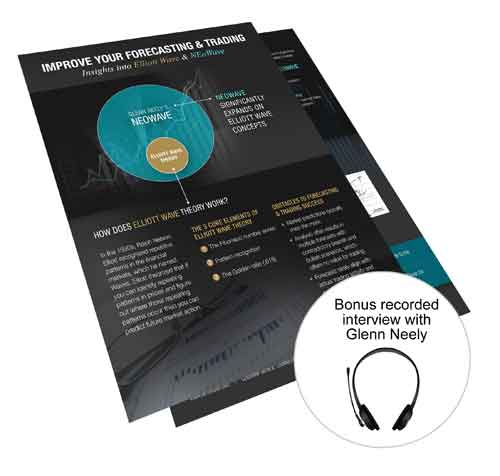NEoWave Blog
11/28/2019 - NEoWave Staff
Article #4 of 7: Glenn Neely compares Elliott Wave rules to NEoWave rules
Introductory note: This is Part 4 of a 7-part series. In these articles, Glenn Neely, NEoWave founder and author of Mastering Elliott Wave, discusses Elliott Wave concepts from his unique point of view as a world-renowned Elliott Wave expert. In this frank, open, and insightful interview, Mr. Neely reveals his advanced forecasting and trading concepts – based on his decades of experience as the creator of NEoWave forecasting and his exciting Neely River Trading Technology, which fuels profitable trading results.
The topic of “rules” is probably the greatest dividing point between orthodox Elliott Wave and NEoWave forecasting. Traditional, orthodox Elliott Wave has a very limited set of rules. Before my book (
Mastering Elliott Wave) was published, many people thought Elliott Wave was somewhat complicated and unnecessarily detailed. However, when it comes to rules, comparing orthodox
Elliott Wave to NEoWave is like comparing grade school math to calculus. NEoWave is vastly more complicated and vastly more detailed – for good reason. Thanks to additional rules,
NEoWave forecasting is exponentially more accurate.
Unlike orthodox Elliott Wave, NEoWave describes virtually every type of market action, every type of behavior, every type of pattern, and all the minor variations inside of each pattern. NEoWave is tremendously more complicated. But, because of this, NEoWave allows you to be much more precise about your forecast, your expectations, and your confidence level.
This also takes us to an important difference between orthodox Elliott Wave and NEoWave forecasting. Since there are more rules with NEoWave, you sometimes may not understand what’s going on in the market you are following – and that’s actually a good thing. Why? Because when you have more rules to apply and you don’t know what’s going on, 9 times out of 10 it’s because the market is not at an important turning point. This means you’re not wasting your time trading, believing you know what is going to happen, when it turns out you were actually wrong. Relying on fuzzy predictions does not result in profitable trades.
That’s a very common phenomenon with orthodox Elliott Wave, because it’s so simplistic and it’s more of a trend-following kind of technology. For example, you may say the trend is up when you’re in a bull market or the trend is down in a bear market, but you’re not prepared for the counter-trend moves that can be violent, dangerous, and costly. This means you’re into trades that turn out to be completely unjustified, and you get caught in really bad situations. When you try to adjust the Wave count in a bad trade – and that bad trade keeps getting worse because you keep adjusting your count and justifying what you think is the uptrend or the downtrend – eventually you lose so much money you have to give up.
On the other hand, probably 80% of the time you would take a move with orthodox Elliott Wave, you would not with NEoWave, because you would know you’re not at the end of a pattern. You know you’re not at a crucial juncture. So you save yourself a lot of wasted time, wasted money, aggravation, and waiting through dead periods. This is because, with NEoWave, you have very specific time rules and price behavior rules that force you to wait until you’re entering a period where you’re likely to actually produce a top or bottom, and you can start to consider getting in, trading, and making money.
When it comes to orthodox Elliott Wave rules, there are no timing parameters at all. You don’t know how long the market is going to take to correct. You just jump in, and you might wait for weeks or months. It might turn out you’re completely wrong, because your analysis is too general and not specific. There are a lot of problems that occur with orthodox Elliott Wave’s lack of rules that are avoided when using NEoWave, because of the very specific rules designed for each pattern and the process of analysis.
Here is a final thought: When I published my book, a lot of people thought I was trying to change Elliott Wave. I’m not changing anything about orthodox Wave theory. That would be like saying calculus changed algebra. So, no, NEoWave does not change Elliott Wave. But thanks to the rules, logic, and scientific approach I introduced in my book, NEoWave allows you to figure out much more complicated situations. NEoWave is a much more reliable Wave trend indicator than traditional, orthodox Elliott Wave – particularly when it comes to rules.
Elliott Wave vs. NEoWave: How do they compare?
The three core elements of Elliott Wave are:
- The Fibonacci number series
- Pattern recognition
- The Golden ratio (.618)
All three elements have a “forecasting” or “anticipatory” aspect, in which the analyst is expecting the market to move up or down a certain number of “waves,” which adhere to a predictable design and have specific relationships.
The three core elements of NEoWave are:
- Logic (e.g., a strong correction must yield a powerful move),
- Self-defining price/time limits (e.g., a smaller degree pattern cannot take more time and price than a larger degree pattern), and
- Self-Confirmation (i.e., the market's post-pattern behavior determines whether your prior structural analysis was correct).
All three NEoWave elements have a “back-casting” or “reactionary” aspect, where the analyst is making sure (after the fact) a pattern did not take too much or too little time, that it was not too complex or too simple, and that post-pattern price action achieved the minimum movement required to confirm the prior pattern.
Read the articles in this 7-part series:
Article #1,
Article #2,
Article #3,
Article #4,
Article #5,
Article #6,
Article #7
Get 2 educational tools FREE!
Get Real-World Advice for Better Forecasts and Trades for FREE! Sign Up Now!
Learn more about:
NEoWave Trading Service
NEoWave Forecasting Service
Mastering Elliott Wave by Glenn Neely
Follow us @NEoWaveTheory:
Twitter: https://twitter.com/NEoWaveTheory
Facebook: https://www.facebook.com/NEoWaveTheory


